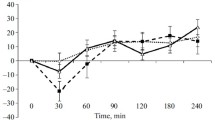Abstract
The effects of levallorphan, a narcotic-antagonist analgesic, were studied on locomotor activity, operant behavior (continuous avoidance schedule), and brain monoamine content in the rat. Levallorphan produced an increase in locomotor activity and in the rate of avoidance responding. Brain norepinephrine was significantly decreased 1 h after 256 mg/kg of levallorphan. Brain dopamine (DA) levels were lowered by 64 and 256 mg/kg of levallorphan. There was no effect on brain serotonin levels. The stimulant effects of levallorphan on operant behavior were blocked by simultaneous administration of naloxone. A clear antagonism of the effects of levallorphan on locomotor activity by naloxone could be demonstrated for low doses of levallorphan but not for doses above 16 mg/kg. Naloxone also failed to prevent the depletion of brain catecholamines produced by levallorphan. Naloxone alone had no consistent effect on either of the behaviors under observation or on brain monoamine content. These findings indicate that levallorphan is a stimulant of behavior in the rat, and that the stimulant action is mediated by at least two mechanisms: one which is blocked by naloxone, and one which is not. Furthermore, it is suggested that the rat should be considered as a possible animal model in which to study the agonistic properties of certain narcotic-antagonist analgesics on behavior.
Similar content being viewed by others
References
Ansell, G. B., Beeson, M. F.: A rapid and sensitive procedure for the combined assay of noradrenaline, dopamine, and serotonin in a single brain sample. Analyt. Biochem. 23, 196–206 (1968).
Archer, S., Harris, L. S., Albertson, N. F., Tullar, B. F., Pierson, A. K.: Narcotic antagonists as analgesics; laboratory aspects. In: Molecular Modification in Drug Design, Advances in Chemistry Series No. 45. R. F. Gould (ed.), pp. 162–169. American Chemical Society 1964.
Blumberg, H., Dayton, H. B., George, M., Rappaport, D. N.: N-allylnoroxymorphone: a potent narcotic antagonist. Fed. Proc. 20, 311 (1961).
Collier, H. O. J., Schneider, C.: Some agonist and antagonist properties of morphine antagonists in rodents. In: Agonist and Antagonist Actions of Narcotic Analgesic Drugs. H. W. Kosterlitz, H. O. J., Collier and J. E. Villarreal, eds., pp. 128–135. Baltimore: University Park Press 1973.
Dews, P. B., Morse, W. H.: Behavioral pharmacology. Ann. Rev. Pharmacol. 1, 145–174 (1961).
Eddy, N. B., Martin, W. R.: Drug dependence of specific opiate antagonist type. Pharmakopsychiat. Neuro-Psychopharmak. 3, 73–82 (1970).
Edwards, A. L.: Experimental Design in Psychological Research. New York: Holt, Rinehart and Winston 1965.
Fraser, H. F., Harris, L. S.: Narcotic and narcotic antagonist analgesics. Ann. Rev. Pharmacol. 7, 277–300 (1967).
Heise, G. A., Boff, E.: Continuous avoidance as a base-line for measuring behavioral effects of drugs. Psychopharmacologia (Berl.) 3, 264–282 (1962).
Holtzman, S. G., Jewett, R. E.: Interactions of morphine and nalorphine with physostigmine on operant behavior in the rat. Psychopharmacologia (Berl.) 22, 384–395 (1971).
Holtzman, S. G., Jewett, R. E.: Some actions of pentazocine on behavior and brain monoamines in the rat. J. Pharmacol. exp. Ther. 181, 346–356 (1972a).
Holtzman, S. G., Jewett, R. E.: Stimulation of behavior in the rat by cyclazocine. Proc. V. Int. Cong. Pharmacol. p. 105 (1972b).
Kelleher, R. T., Morse, W. H.: Determinants of the specificity of behavioral effects of drugs. Ergebn. Physiol. 60, 1–56 (1968).
Martin, W. R.: Opioid Antagonists. Pharmacol. Rev. 19, 463–521 (1967).
McMillan, D. E., Harris, L. S.: Behavioral and morphine-antagonist effects of the optical isomers of pentazocine and cyclazocine. J. Pharmacol. exp. Ther. 180, 269–279 (1972).
McMillan, D. E., Morse, W. H.: Some effects of morphine and morphine antagonists on schedule-controlled behavior. J. Pharmacol. exp. Ther. 157, 175–184 (1967).
McMillan, D. E., Wolf, P. S., Carchman, R. A.: Antagonism of the behavioral effects of morphine and methadone by narcotic antagonists in the pigeon. J. Pharmacol. exp. Ther. 175, 443–458 (1970).
Rethy, C. R., Smith, C. B., Villarreal, J. E.: Effects of narcotic analgesics upon the locomotor activity and brain catecholamine content of the mouse. J. Pharmacol. exp. Ther. 176, 472–479 (1971).
Schneider, C.: Behavioral effects of some morphine antagonists and hallucinogens in the rat. Nature (Lond.) 220, 586–587 (1968).
Sidman, M.: Avoidance conditioning with brief shock and no exteroceptive warning signal. Science 118, 157–158 (1953).
Spector, S., Sjoerdsma, A., Udenfriend, S.: Blockade of endogenous norepinephrine synthesis by α-methyl-tyrosine, an inhibitor of tyrosine hydroxylase. J. Pharmacol. exp. Ther. 147, 86–95 (1965).
Villarreal, J. E.: Recent advances in the pharmacology of morphine-like drugs. In: Advances in Mental Science, Vol. 2: Drug Dependence. R. T. Harris, C. R. Schuster and D. McIsaac, eds., pp. 83–116. Austin: University of Texas Press 1970.
Weiss, B., Laties, V. G.: Behavioral pharmacology. Ann. Rev. Pharmacol. 9, 297–326 (1969).
Wray, S. R., Cowan, A.: The effects of naloxone, chlorpromazine, and haloperidol pretreatment on levallorphan-induced disruption of rats' operant behavior. Psychopharmacologia (Berl.) 22, 261–270 (1971).
Author information
Authors and Affiliations
Additional information
Publication No. 1137 of the Division of Basic Health Sciences of Emory University. This investigation was supported by USPHS Grants MH 12870, MH 21699 and T01 GM00179.
This work represents partial fulfillment of the requirements for the degree of Master of Science.
Rights and permissions
About this article
Cite this article
Steinert, H.R., Holtzman, S.G. & Jewett, R.E. Some agonistic actions of the morphine antagonist levallorphan on behavior and brain monoamines in the rat. Psychopharmacologia 31, 35–48 (1973). https://doi.org/10.1007/BF00429297
Received:
Issue Date:
DOI: https://doi.org/10.1007/BF00429297




